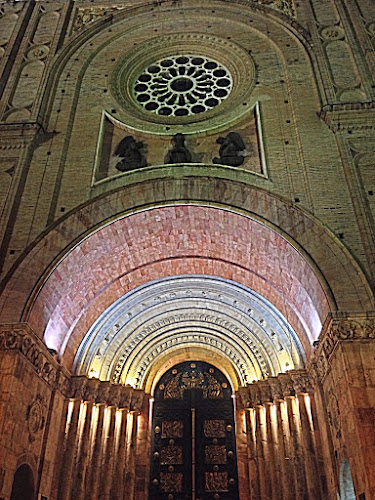The main plaza is our favoured point of reference when tackling a new town or city. On the app-map they're invariably the large pale green square set in the middle of a grid of boxes. The genuine centre to which the Spartan road signage tries to point. They're generally a refuge away from the heavy goods traffic, a hot sun and the hive of moto-taxis.
For us, in particular, they are a place to park-up and drink deep shade. To take a breather from the shock of negotiating unregulated junctions, semaphoring traffic lights and wayward wandering pedestrians. Then for the Forager to deploy her divination and recce a room for the night.
Throughout all our southern travels, these plazas have come with certain characteristics, a certain conservative ground plan: The Catholic Church, in one of it's many guises, a clutch of telecom vendors and a fist of Banks, all facing in on some notable personage, column busted or astride a prancing horse, invariably poking the sky with a sword. The plan will always be a square. That is, until we reached Ecuador.
The frontier town of Macarà was our first encounter with un-gridded streets laced with un-rideable gradients. Its plaza defies any recognisable geometric description; likewise the accoutrements of archetypical architecture. A chapel and a basilica stand at opposite corners, the latter, when floodlit, is a pink and yellow blancmange, so defying of the mandatory Papal yellow on white. The council 'gin-palace' is rendered in brutalist concrete and occupies yet another quadrant. It's the final face that is unique. An airport terminal. Where many towns can be divided along rail tracks, Macará has a runway traversing its entire length, whose main purpose appears to be a dog walking trail and jogging track.
By the time we've reached Cuenca, we've started to get the measure of Sr. Town Planner and his partner Sr. Road Engineer. Gradients in excess of 9% are permissible, hairpin bends are not, and in town, replacement with flights of stairs, a useful solution; just don't note them on an app-map. Widening the sidewalk and installing one-way traffic management is the start of a 'liveable city', only it might be useful to alternate the 'una-vias'. Installing a two-way cycle path, but allowing it to disgorge you onto every unregulated roundabout renders it problematic. As you might have guessed, it took a good deal of quartering and quandering to reach Cuenca's central plaza. It felt like we had circumnavigated its old town twice. It was worth it.
The old colonial centre is on a grid, is peppered with plazas, each with an attendant cathedral, basilica or capilla. Held in place by steep valley hilsides and the Rio Tomebamba, whose cliff-like banks have given rise to those long flights of stairs that so thwarted our entry.
We keep to the script and eventually park up in the plaza, (Parque Calderón...which gives you an idea as to who is stuck up on his column, trying to puncture a cloud), sitting under manicured mesquites and soaring podocarps. Arboreal architecture that complements the vast, imposing monumental edifice of the city's 'new' cathedral. I don't know where the Navigator found her diabolical divining rods, only it bothers me, given that I'm surrounded by so much ecclesiasticalism. But I do know that they work. She returns to our corral of cycles with a smile...."wait till you see what I've found...." Maybe she employs the services of our 'guardian angel' or just has a dead reckoning instinct. Whatever; it's colonial in style, a balcony room that overlooks the plaza and the Santo Domingo church. Our bikes are parked behind a stuffed sofa in the 'palm court' of the secluded central atrium, there to complement the chaise longue, the ornaments and antiques; there's even a piano, just no pianist.
It oozes that potential for 'slow death' and 'faded grandeur', an ambiance that you know will never materialise, if only because of Julio the dueño owner. Even the cleaning regime is in keeping. No mechanical device attacks the Axminster. Whilst not quite 'the sprinkled tea-leaves' of an inter-war Britain, the principle is the same. A damp cloth wiped over the surface before a gentle broom sweep. It could descend into a pastiche if it wasn't so genuine.
It's all so at a variance with the antiseptic norm of the generic, bland-washed, star-encrusted 'international hotel'.
So good... we didn't buy it, but did end up staying several nights.




